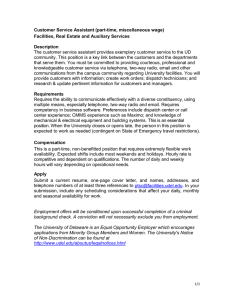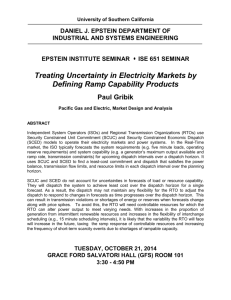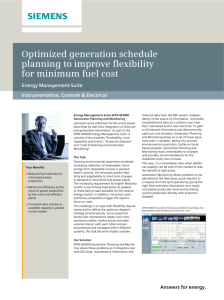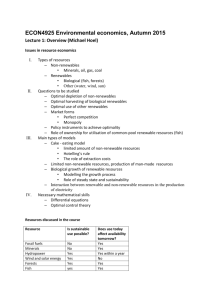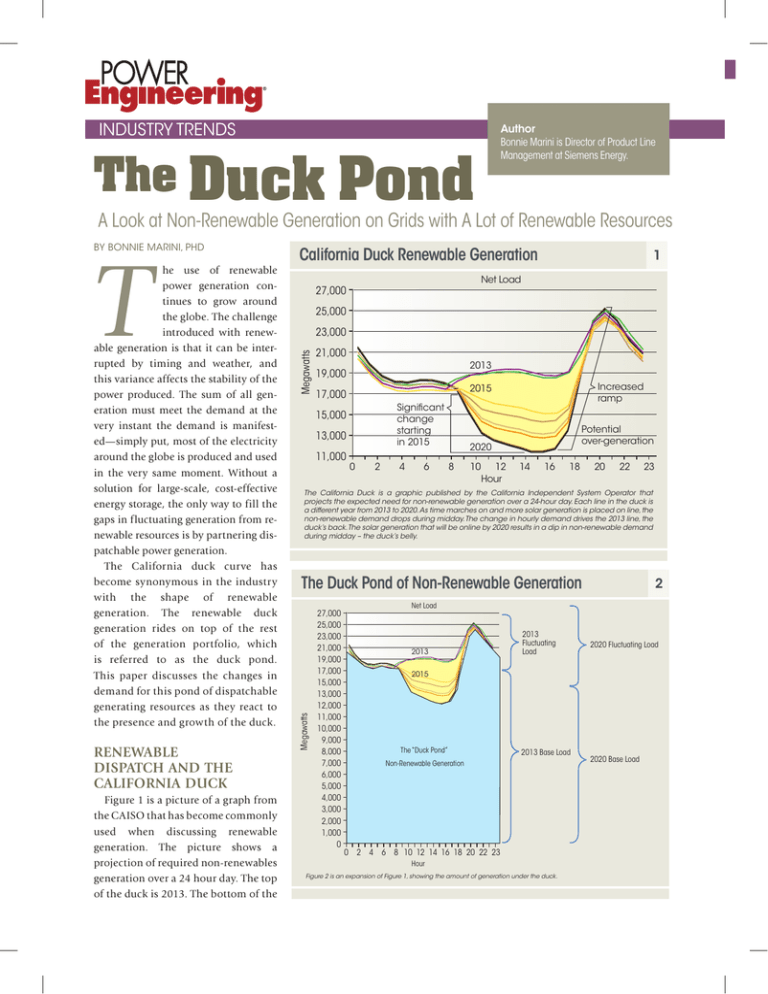
INDUSTRY TRENDS
The Duck
Author
Bonnie Marini is Director of Product Line
Management at Siemens Energy.
Pond
A Look at Non-Renewable Generation on Grids with A Lot of Renewable Resources
RENEWABLE
DISPATCH AND THE
CALIFORNIA DUCK
Figure 1 is a picture of a graph from
the CAISO that has become commonly
used when discussing renewable
generation. The picture shows a
projection of required non-renewables
generation over a 24 hour day. The top
of the duck is 2013. The bottom of the
California Duck Renewable Generation
1
Net Load
27,000
25,000
23,000
Megawatts
T
he use of renewable
power generation continues to grow around
the globe. The challenge
introduced with renewable generation is that it can be interrupted by timing and weather, and
this variance affects the stability of the
power produced. The sum of all generation must meet the demand at the
very instant the demand is manifested—simply put, most of the electricity
around the globe is produced and used
in the very same moment. Without a
solution for large-scale, cost-effective
energy storage, the only way to fill the
gaps in fluctuating generation from renewable resources is by partnering dispatchable power generation.
The California duck curve has
become synonymous in the industry
with the shape of renewable
generation. The renewable duck
generation rides on top of the rest
of the generation portfolio, which
is referred to as the duck pond.
This paper discusses the changes in
demand for this pond of dispatchable
generating resources as they react to
the presence and growth of the duck.
21,000
2013
19,000
Significant
change
starting
in 2015
13,000
11,000
Increased
ramp
2015
17,000
15,000
0
2
4
6
Potential
over-generation
2020
8
10
12
Hour
14
16
18
20
22
23
The California Duck is a graphic published by the California Independent System Operator that
projects the expected need for non-renewable generation over a 24-hour day. Each line in the duck is
a different year from 2013 to 2020. As time marches on and more solar generation is placed on line, the
non-renewable demand drops during midday. The change in hourly demand drives the 2013 line, the
duck’s back. The solar generation that will be online by 2020 results in a dip in non-renewable demand
during midday – the duck’s belly.
The Duck Pond of Non-Renewable Generation
Megawatts
BY BONNIE MARINI, PHD
27,000
25,000
23,000
21,000
19,000
17,000
15,000
13,000
12,000
11,000
10,000
9,000
8,000
7,000
6,000
5,000
4,000
3,000
2,000
1,000
0
2
Net Load
2013
2013
Fluctuating
Load
2020 Fluctuating Load
2015
The “Duck Pond”
2013 Base Load
Non-Renewable Generation
0
2 4 6 8 10 12 14 16 18 20 22 23
Hour
Figure 2 is an expansion of Figure 1, showing the amount of generation under the duck.
2020 Base Load
Daily Total and Non-Renewable Demand - Load Net Load (2/24/2013)
28,000
3
Load
Net Load
27,000
Load & Net Load (MW)
26,000
25,000
24,000
23,000
22,000
21,000
20,000
19,000
23.00
22.00
21.00
20.00
19.00
18.00
17.00
16.00
15.00
14.00
13.00
12.00
11.00
10.00
9.00
8.00
7.00
6.00
5.00
4.00
3,00
2.00
1.00
0.00
18,000
Figure 3 is another example of total demand and non-renewable demand over the course of a day.
duck’s belly is 2020. What can be seen
from the duck is that the solar power
generated during the day will result in
a need for non-renewable resources to
ramp down in the morning and ramp
up in the evening.
It should be noted that the
California duck curve of Figure 1 is
a picture of one particular day. Since
weather is a big factor, the curve
changes every day.
A glance at any of these curves
can result in an impression that
most of the other generation on the
grid will need to ramp on and off
in order to support the renewables
however in Figure 1 the y-axis is cut
off at 11 Gigawatts. It is interesting to
note that the duck’s belly is marked
“potential over-generation risk”.
Clearly this “overgeneration” is not
due to the renewables producing
more power than the grid demands.
It is due to the expected behavior of
the resources providing that 12 to
15 GW – the generators that fill the
duck pond. Figure 2 is an expansion
of Figure 1, showing the amount of
generation under the duck.
WHAT CHANGED
AND WHAT DIDN’T
Historically, different types of
power plants were used for different
types of dispatch. Figure 2 shows
how the split between base load and
f luctuating load plants is changing.
Fewer base load plants and more
f luctuating load plants are needed
to integrate with renewables. The
concern is that there are too many
base load plants and not enough
f luctuating load plants. If the base
load plants can’t be turned down or
shut down, there is overgeneration.
Using the same example graph,
moving from the 2013 scenario, the
steady base load was about 18 GW.
In the 2020 scenario the steady load
is about 12 GW, which means that 6
GW of generators had to switch from
being base loaded to f luctuating load.
Looking at the curve, we can see
that it is not just the amount of
f luctuating generation that changes,
it is also the amount of time these
resources are dispatched. In the 2013
scenario, most of this f luctuating
generation is dispatched less than
20 percent of the time. In the 2020
scenario, many of the f luctuating
resources are running more than 60
percent of the time. This changes both
the economic and environmental
impact of these f luctuating resources.
One other factor that has been a
point of discussion with renewable
integration is ramp rate. Figure 3
shows another example of total
demand and non-renewable demand
over the course of a day. The blue line
depicts total demand and the lower
red line depicts the net demand which
in this case is defined as the nonrenewable demand. This shows that
even without renewables, power had
to ramp up and down in order to meet
demand. The difference between the
past and the future is not the existence
or rate of the ramp but simply the
amount of energy that needs to ramp.
The charts illustrate that increasing
renewables:
• will decrease the base load nonrenewable generation
• will increase the amount of fluctuating non-renewable generation
• will increase the amount of
INDUSTRY TRENDS
Megawatts
Dispatch Regimes
27,000
25,000
23,000
21,000
19,000
17,000
15,000
13,000
12,000
11,000
10,000
9,000
8,000
7,000
6,000
5,000
4,000
3,000
2,000
1,000
0
4
Peaking dispatch
2013
Medium dispatch
2015
Base dispatch
The duck pond can be broken into three different kinds of operation: Base load; mid load; and peaking load
Examples of Dispatch on a Grid with Renewables
35,000
Generation (MW)
Wind
Net Demand
Demand
30,000
5
Solar
Simple Cycle
25,000
Combined Cycle
20,000
Hydro
15,000
Gas Fired Steam Turbine
Cogen
10,000
Biomass/Geothermal
5,000
0
Coal Fired Steam Turbine
Nuclear
1
Hour
dispatch of the f luctuating nonrenewable generation
• will require a similar ramp rate
to the f luctuating generation
used in the past
The first reaction to deal with this
non-traditional problem was using a
tradition solution. Some suggested
switching these plants to the types
of plants that had been used for
f luctuating load in the past, for
example simple cycle gas fired power
24
plants, but the change in dispatch
make this solution a less suitable fit
for today’s challenges.
THE RIGHT SOLUTION
FOR FLUCTUATING
GENERATION
The first requirement for a resource
to be used for f luctuating generation
is that it can support f luctuating
operation. For illustrative purposes,
as shown in Figure 4, the duck pond
can be broken into three different
kind of operation:
• Base load = not changing load
frequently
• Mid Load = dispatch for a large
portion of the day, but can reduce
load or shut down for portions
on the day
• Peaking Load = dispatch for
short operational windows and
operate <20% of the time
To support fluctuating load, there are
several types of plants that can be used
• Simple Cycle – Fast start, high
f lexibility, low CapEx, low
efficiency, High LCOE
• Conventional Combined Cycle –
Slow Start, Capable for Fast Load
Changes, Wide operating range,
Higher CapEx, High Efficiency,
Low LCOE
• Flex-Plant Combined Cycle –
Fast start, Capable for Fast Load
Changes, Wide operating range,
Higher CapEx, High Efficiency,
Low LCOE
In addition to technical capability,
the decision between technologies
depends on economics. For a low
dispatch plant, low CapEx is more
critical than low LCOE.
For a high dispatch plant, the
opposite is true. Low LCOE is the
more critical factor. Typically for
plants that dispatch less than 10
percent to 20 percent the economics
favor simple cycles. For plants which
dispatch more, the fuel savings
benefit of the combined cycles results
in better economics for the high
efficiency combined cycles.
Prior to the growth of f luctuating
renewables much of the f luctuating
load was low dispatch. The solution
for this demand was simple cycle.
Today’s medium dispatch demands
are different.
To gain a broader understanding
of how future dispatchable resources
will need to behave in order to
accommodate increased renewable
Examples of Dispatch on a Grid with Renewables
12,000
Ramp Rate of
>2,500 MW/hr
10,000
Generation (MW)
6
8,000
6,000
4,000
2,000
0
1
24
Hour
Ramping Support from Combined Cycle Power Plants
CONVENTIONAL
COMBINED CYCLES FOR
FLUCTUATING DEMANDS
Changing load is not only due
to changing dispatch of renewable
generation. It is also due to constant
changes in demand which happen all
of the time. Conventional combined
cycle technology has been used to
meet these changing loads for many
years. As shown in Figure 3, the
Examples of Dispatch on a Grid with Renewables
7
Net Demand
50,000
Demand
45,000
Wind
Solar
40,000
Generation (MW)
generation; data developed in two
recent studies of future dispatch
behavior were evaluated with a
specific focus on what types of plants
will be needed to accommodate
increased renewables.
One study was conducted by the
CAISO1 and the other was conducted
by the Ventyx Corporation.
The results of both studies
indicate that the majority of demand
f luctuations will be supported by
combined cycles.
In a future grid, with an increase
of highly fluctuating renewables,
simple cycles will still support low
dispatch, peaking demands. Whereas,
combined cycles are a better choice for
the rest of the pond if they can meet
the fluctuating demand – and analysis
and history shows that they can.
during the day. The magnitude of the
energy supplied makes it practical to
use large combined cycle plants to
support this need. The red line on
Figure 5 represents the simple cycles.
In this case they are dispatched;
however they are not used to cover the
changes in demand. Their dispatch is
rather f lat, and the amount of energy
dispatched is minimal. It is less costly
and more environmentally friendly
to use the combined cycles to cover
large demand changes so they are
used first.
Figure 7 and Figure 8 show a
Simple Cycle
35,000
30,000
Cogen
25,000
Combined Cycle
20,000
Hydro
15,000
Biomass/Geothermal
10,000
Gas Fired Steam Turbine
5,000
Coal Fired Steam Turbine
0
1
Hour
ramps seen with renewables are not
expected to be faster than the ramps
previously seen in the market – they
are only larger and longer.
Figure 5 is a simulation of a winter
day on the Huntington Beach grid
in California. Many of the plants
modeled are not advanced FlexPlant combined cycles, but are
conventional cycles. Figure 6 focuses
on the energy provided by combined
cycles and shows they are providing
majority of the ramping support. The
power from combined cycles ramps
up and down to cover two peaks
24
Nuclear
projected summer day, in Huntington
Beach. Again, the dispatch of the
simple and combined cycle’s show
that the larger share of demand
change is supported by combined
cycles. In this case, the overall
demand is high, and the simple
cycles are dispatched to meet the
peak in demand. This dispatch order
on a high renewable grid is similar to
the dispatch order on a conventional
grid. Combined cycles dispatch first
because they offer a lower cost of
generation followed by simple cycles
meet peaks in demand. There is no
INDUSTRY TRENDS
Generation (MW)
Generation (MW)
Simple Cycle and Combined Cycle Dispatch
20,000
high ramping capability, they are not
designed to start fast and frequently.
Newer flexible combined cycle plants
can start as fast as a simple cycle while
still maintaining full equipment life,
making multiple restarts viable even
for large combined cycles.
A good example of a f lexible
combined cycle which uses the
advantage of fast start is the Siemens
H-Class power plant which has been
operating since 2012 in Irsching,
Germany. Figure 10 shows an
example of the plant operation as it
starts quickly in the morning, follows
demand during the day, shuts down
in the evening, and repeats this
pattern the next day. With Siemens
8
Gas – Simple Cycle
15,000
10,000
5,000
0
20,000
1
3
5
7
9
11
13
Hour
15
17
19
21
23
9
11
13
Hour
15
17
19
21
23
Gas - Combined Cycle
15,000
10,000
5,000
0
1
3
5
7
40,000
30,000
Wind
25,000
Solar
Hydro
10,000
Gas Fired Steam Turbine
5,000
Coal Fired Steam Turbine
Nuclear
1
Hour
indication of a need for more simple
cycles to support load changes.
Similar data was extracted for a
node in Texas, which has the largest
supply of wind power in the US.
Figure 9 illustrates that the same
phenomenon can be observed there
as well. The vast majority of load
changes are supported by combined
cycles first. Simple cycles are used
primarily for peak demand and are not
critical for supporting the large ramps
in load that were seen in the past, or
the even larger ramps in load that are
24
Combined Cycle
5,000
0
Combined Cycle
15,000
9
10,000
Simple Cycle
20,000
0
15,000
Generation (MW)
Generation (MW)
35,000
Generation (MW)
A Day in Texas - Simple Cycle and Combined Cycle Dispatch
1,000
800
600
400
200
0
1
3
5
7
9
11 13
Hour
15
17
19
21
23
9
11 13
Hour
15
17
19
21
23
Simple Cycle
1
3
expected in the future. Combined
cycles are able to change load quickly
and ultimately dispatch first due to
the lower cost of generation.
FLEXIBLE COMBINED
CYCLES FOR RENEWABLE
SUPPORT
While conventional combined cycles
offer advantages over simple cycles
for renewable integration, modern
Flex-Plant combined cycles offer
significantly more capability. While
conventional combined cycles have
5
7
Flex-Plants there is no need to trade
efficiency for f lexibility. This plant
exceeds 60% net combined cycle
efficiency and can add 500 MW of
generation to the grid in 30 minutes.
Operating Flex-Plants in the U.S.
include Lodi Energy Center in Lodi,
California and the Temple and
Sherman plants in Texas.
Unlike
most
simple
cycles,
combined cycles often have a very
large load range, enabling them to
ramp up and down without having to
shut down and restart.
Typical Daily Operation at SCC5-8000H
in Irsching Germany
250
Reliable plant startup
200
On Grid
Control
10
Fast, controlled
ramp up & down
MW
150
100
50
0
–50
0:00
4:48
2:24
7:12
9:36
14:24
19:12
0:00
4:48
9:36
14:24
19:12
0:00
12:00
16:48
21:36
2:24
7:12
12:00
16:48
21:36
2:24
Time
ENVIRONMENTAL
CONSIDERATIONS
Today efficiency is not just an economic factor, it is also an environmental consideration. Greenhouse gas production is directly related to efficiency,
and recently issued EPA rules are one
example of the requirements for future
generation. In the EPA’s Carbon Pollution Standards issued this year, in order to manage carbon dioxide production, low efficiency plants are limited
in dispatch based on their efficiency.
For plants with less than 50% efficiency based on LHV, the plant’s dispatch
is limited to its equivalent LHV based
efficiency. For example, a simple cycle
plant with 35 percent net efficiency
may not dispatch more than 35 percent
of the time. Again looking at Figure 4,
it is expected that a large group of fluctuating plants will be needed to dispatch at higher levels, adding another
driver for the use of combined cycles
for renewable integration.
FITTING THE PLANT
TO THE NEED
It seems rare when a choice is
better in functionality, cost, and
environmental footprint, but for
high dispatch plants, combined cycles win in all three areas. Flexible
combined cycle power plants support the renewable concept by being
more efficient, cleaner for the environment and f lexible to meet the
change in demand.
For low dispatch plants, a traditional
approach still makes sense. The lowest
CapEx solution with high flexibility
is a good fit, and this is typically a
simple cycle frame unit.
CONCLUSION
The growing portfolio of renewable
resources has resulted in the addition
of a large demand for high dispatch,
f luctuating generation. This demand
regime is not served by plants which
cannot change load, and is not
served well by low efficiency plants
designed for peaking. This growing
market segment needs a solution
with high operating efficiency, low
LCOE, high ramping f lexibility and
fast start. The new generation of FlexPlant combined cycles offer these
benefits. Use of the right solutions
for these various load regimes will
support the environmental benefit
of renewable generation while
managing the cost of generation
with cost effective, high efficiency
plants.
Electronic and single printed copies or distribution with permission to Siemens Energy from Power Engineering
March © 2016 PennWell Corporation
Siemens’ Flex-Plants™
A trusted partner for renewables
©Siemens, 2016. All Rights Reserved.
The continued growth of renewable energy generation
puts power supply at nature‘s whim. The potential for rapid
fluctuations in generation must be quickly balanced to maintain
a reliable supply of power to the grid. With all of the flexibility
and features of a peaker and the high efficiency of a combined
cycle plant, proven Flex-Plants from Siemens work in harmony
with renewables, providing efficient and reliable electricity
when the wind stops blowing or the sun stops shining.
FlexPlant Ad-Rebranded.indd 1
As you tackle the challenge of ensuring a reliable power
supply while remaining committed to using natural resources
responsibly, Siemens has the solutions that help you do both.
siemens.com/energy
4/19/16 1:22 PM


